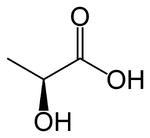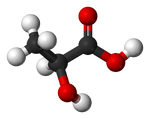| Lactic acid | |
|---|---|
 
| |
| Chemical name | 2-hydroxypropanoic acid |
| Chemical formula | C3H6O3 |
| Molecular mass | 90.08 g/mol |
| CAS number | [50-21-5] L: [79-33-4] D: [10326-41-7] D/L: [598-82-3] |
| Melting point | L: 53 °C D: 53 °C D/L: 16.8 °C |
| Boiling point | 122 °C @ 12 mmHg |
| SMILES | CC(O)C(=O)O |
| Disclaimer and references | |
For the production of milk by mammals, see Lactation.
Lactic acid (IUPAC systematic name: 2-hydroxypropanoic acid), also known as milk acid, is a chemical compound that plays a role in several biochemical processes. It was first isolated in 1780 by a Swedish chemist, Carl Wilhelm Scheele, and is a carboxylic acid with a chemical formula of C3H6O3. It has a hydroxyl group adjacent to the carboxyl group, making it an alpha hydroxy acid (AHA). In solution, it can lose a proton from the acidic group, producing the lactate ion CH3CH(OH)COO−. It is miscible with water or ethanol, and is hygroscopic.
Lactic acid is chiral and has two optical isomers. One is known as L-(+)-lactic acid or (S)-lactic acid and the other, its mirror image, is D-(-)-lactic acid or (R)-lactic acid. L-(+)-Lactic acid is the biologically important isomer.
In animals, L-lactate is constantly produced from pyruvate via the enzyme lactate dehydrogenase (LDH) in a process of fermentation during normal metabolism and exercise. It does not increase in concentration until the rate of lactate production exceeds the rate of lactate removal which is governed by a number of factors including: monocarboxylate transporters, concentration and isoform of LDH and oxidative capacity of tissues. The concentration of blood lactate is usually 1-2 mmol/L at rest, but can rise to over 20 mmol/L during intense exertion.
Lactic acid fermentation is also performed by Lactobacillus bacteria. These bacteria can operate in the mouth; the acid they produce is responsible for the tooth decay known as caries.
In medicine, lactate is one of the main components of Ringer's lactate or lactated Ringer's solution. This intravenous fluid consists of sodium and potassium cations, with lactate and chloride anions, in solution with distilled water in concentration so as to be isotonic compared to human blood. It is most commonly used for fluid resuscitation after blood loss due to trauma, surgery or a burn injury.
Exercise and lactate[]
During intense exercise, such as sprinting type activities, when the rate of demand for energy is high, lactate is produced faster than the ability of the tissues to remove it and lactate concentration begins to rise. This is a beneficial process since the regeneration of NAD+ ensures that energy production is maintained and exercise can continue. The increased lactate produced can be removed in a number of ways including: oxidation to pyruvate by well-oxygenated muscle cells which is then directly used to fuel the citric acid cycle and conversion to glucose via the Cori cycle in the liver through the process of gluconeogenesis.
Contrary to popular belief, this increased concentration of lactate does not directly cause acidosis, nor is it responsible for delayed onset muscle soreness.[1] This is because lactate itself is not capable of releasing a proton, and secondly, the acidic form of lactate, lactic acid, cannot be formed under normal circumstances in human tissues. Analysis of the glycolytic pathway in humans indicates that there are not enough hydrogen ions present in the glycolytic intermediates to produce lactic or any other acid.
The acidosis that is associated with increases in lactate concentration during heavy exercise arises from a separate reaction. When ATP is hydrolysed, a hydrogen ion is released. ATP-derived hydrogen ions are primarily responsible for the decrease in pH. During intense exercise, aerobic metabolism cannot produce ATP quickly enough to supply the demands of the muscle. As a result, anaerobic metabolism becomes the dominant energy producing pathway as it can form ATP at high rates. Due to the large amounts of ATP being produced and hydrolysed in a short period of time, the buffering systems of the tissues are overcome, causing pH to fall and creating a state of acidosis. This may be one factor, among many, that contributes to the acute muscular discomfort experienced shortly after intense exercise.[citations needed]
The effect of lactate on acidosis has been the topic of many recent conferences in the field of exercise physiology. Robergs et al. have accurately chased the proton movement that occurs during glycolysis. However, in doing so, they have suggested that [H+] is an independent variable that determines its own concentration. A recent review by Lindinger et al. has been written to rebut the stoichiometric approach used by Robergs et al. In using this stoichiometric process, Robergs et al. have ignored the causitive factors (independent variables) of [H+]. These factors are strong ion difference [SID], PCO2, and weak acid buffers. Lactate is a strong anion, and causes a reduction in [SID] which causes and increase in [H+] to maintain electroneutrality. PCO2 also causes an increase in [H+]. During exercise, intramuscular [lactate] and PCO2 increase, causing an increase in [H+], and thus a decrease in pH. It is unclear as to why Robergs et al. have ignored these independent variables in their review. [SID], PCO2, and [weak acid buffer] have been measured during exercise by Jones et al. The reader interested in acid-base balance during exercise is recommended to consult work by Peter Stewart.
Lactic acid in food[]
Lactic acid is primarily found in sour milk products, such as: koumiss, leban, yogurt, kefir and some cottage cheeses. The casein in fermented milk is coagulated (curdled) by lactic acid.
Although it can be fermented from lactose (milk sugar), most commercially used lactic acid is derived by using bacteria such as Bacillus acidilacti, Lactobacillus delbueckii or Lactobacillus bulgaricus to ferment carbohydrates from nondairy sources such as cornstarch, potatoes and molasses. Thus, although it is commonly known as "milk acid", products claiming to be vegan do sometimes feature lactic acid as an ingredient.
Lactic acid may also be found in various processed foods, usually either as a pH adjusting ingredient, or as a preservative (either as antioxidant or for control of pathogenic micro-organisms). It may also be used as a fermentation booster in rye and sourdough breads.[2]
Lactic acid as a polymer precursor[]
Two molecules of lactic acid can be dehydrated to lactide, a cyclic lactone. A variety of catalysts can polymerise lactide to either heterotactic or syndiotactic polylactide, which as biodegradable polyesters with valuable (inter alia) medical properties are currently attracting much attention.
References[]
- ↑ Robergs R, Ghiasvand F, Parker D (2004). Biochemistry of exercise-induced metabolic acidosis.. Am J Physiol Regul Integr Comp Physiol 287 (3): R502-16. PMID 15308499.
- ↑ "Food Applications". Galactic Div. of Finasucre. 2006. http://www.lactic.com/
See also[]
- Cori cycle
- Alanine cycle
External links[]
- Lactic acid and running: myths, legends and reality
- Biochemistry of exercise-induced metabolic acidosis.
- Link page to external chemical sources.
| This page uses Creative Commons Licensed content from Wikipedia (view authors). |